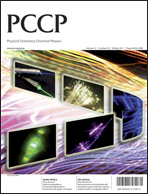The icosahedral Al−13 is a “magic” cluster with remarkable stability due to its high symmetry and closed valence shells. Its reactivity has provided a molecular model for understanding oxidation and dissolution processes in bulk metals. By first principles calculations, we demonstrated the importance of dynamic factors in the Al−13 + HX reactions, with HX being either HCl or HI. There was a barrier to the dissociative adsorption of HX on the surface of an Al−13cluster, which involved charge transfer from Al−13. Furthermore, the H atom could be bonded to the cluster in multiple ways, similar to the top, bridge and hollow adsorption sites on Al(111) surface. With a large amount of energy (∼40 kcal mol−1) deposited during the formation of Al13HX−, the H atom could easily migrate among these sites, similar to the diffusion of hydrogen on metal surfaces. These factors were therefore important considerations in the formation and dissociation of Al13HX−, and more generally in reactions involving other metal clusters.

You have access to this article
 Please wait while we load your content...
Something went wrong. Try again?
Please wait while we load your content...
Something went wrong. Try again?


 Please wait while we load your content...
Please wait while we load your content...